Systemair Bundle
Can Systemair Continue Its Ventilation Revolution?
Systemair, a global force in ventilation, is making waves with its strategic moves, particularly its 2024 acquisition of Eneren, a bold step into heat pump technology. This acquisition is a clear signal of Systemair's ambition to dominate the HVAC market, expanding its reach and product offerings. Founded in 1974, the company has evolved from a Swedish innovator into a global powerhouse.
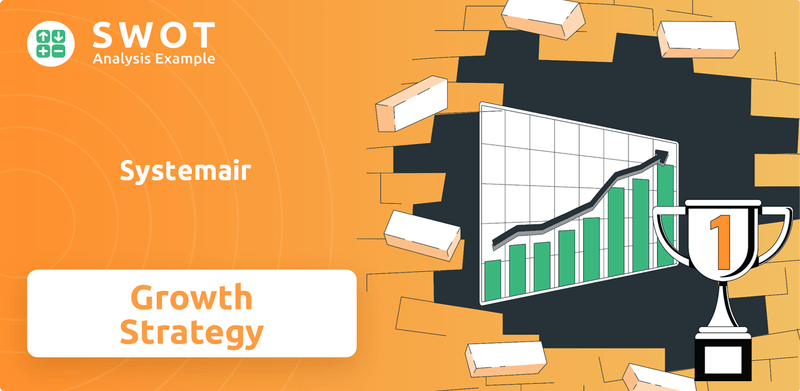
This Systemair SWOT Analysis will explore the company's ambitious plans for the future. With a presence spanning 50 countries, Systemair's future prospects look promising, driven by strategic initiatives focused on innovation and market expansion. The company's commitment to sustainable growth and its robust financial performance will be key drivers in the competitive ventilation solutions landscape.
How Is Systemair Expanding Its Reach?
The core of the Systemair growth strategy hinges on strategic expansion, focusing on both geographical reach and product diversification. This approach includes mergers and acquisitions, like the 2024 acquisition of Eneren, which significantly boosts its capabilities in heat pump technology and integrated systems. This move is designed to tap into new customer segments and diversify revenue streams by offering more comprehensive and energy-efficient climate solutions.
Systemair actively seeks to enter new geographical markets, especially in regions with high growth potential for sustainable building solutions and HVAC infrastructure. Investments in markets like India, where Systemair India Private Limited is expanding its manufacturing capacity, demonstrate a clear commitment to international growth. The company is also expanding its product pipeline to include advanced air conditioning units and chillers, driven by the increasing demand for efficient cooling solutions due to global warming.
Partnership strategies are also key, with Systemair collaborating with industry leaders and technology providers to enhance its offerings and market penetration. These initiatives ensure Systemair remains competitive and adaptable to evolving industry changes, positioning the company for sustained growth in the global ventilation and air conditioning market. The company's focus on innovation and strategic acquisitions underscores its commitment to long-term growth and market leadership.
Systemair's growth strategy includes strategic acquisitions to expand its product portfolio and market presence. The acquisition of Eneren in 2024 is a prime example, enhancing its capabilities in heat pump technology. These acquisitions are crucial for driving revenue growth and increasing market share in the HVAC market.
Systemair is actively expanding its geographical footprint, targeting regions with high growth potential. This includes investments in emerging markets like India, where manufacturing capacity is being increased. The company's global market presence is a key driver of its long-term growth potential.
Product innovation is central to Systemair's strategy, with a focus on advanced air conditioning units and chillers. This focus aligns with the growing demand for efficient cooling solutions. New product launches and continuous innovation are key to maintaining a competitive edge.
Systemair emphasizes partnership strategies, collaborating with industry leaders to enhance its offerings. These partnerships help to improve market penetration and ensure the company remains adaptable. Strategic alliances are crucial for navigating the competitive landscape.
Systemair's expansion initiatives are designed to drive sustained growth in the global ventilation and air conditioning market. These initiatives include strategic acquisitions, geographical expansion, and product innovation, all aimed at increasing market share and revenue.
- Strategic Acquisitions: Acquisitions like Eneren in 2024 enhance product offerings.
- Geographical Expansion: Focus on high-growth markets, such as India, to increase global presence.
- Product Innovation: Development of advanced air conditioning units and chillers to meet market demands.
- Partnerships: Collaborations with industry leaders to enhance offerings and market penetration.
Systemair SWOT Analysis
- Complete SWOT Breakdown
- Fully Customizable
- Editable in Excel & Word
- Professional Formatting
- Investor-Ready Format
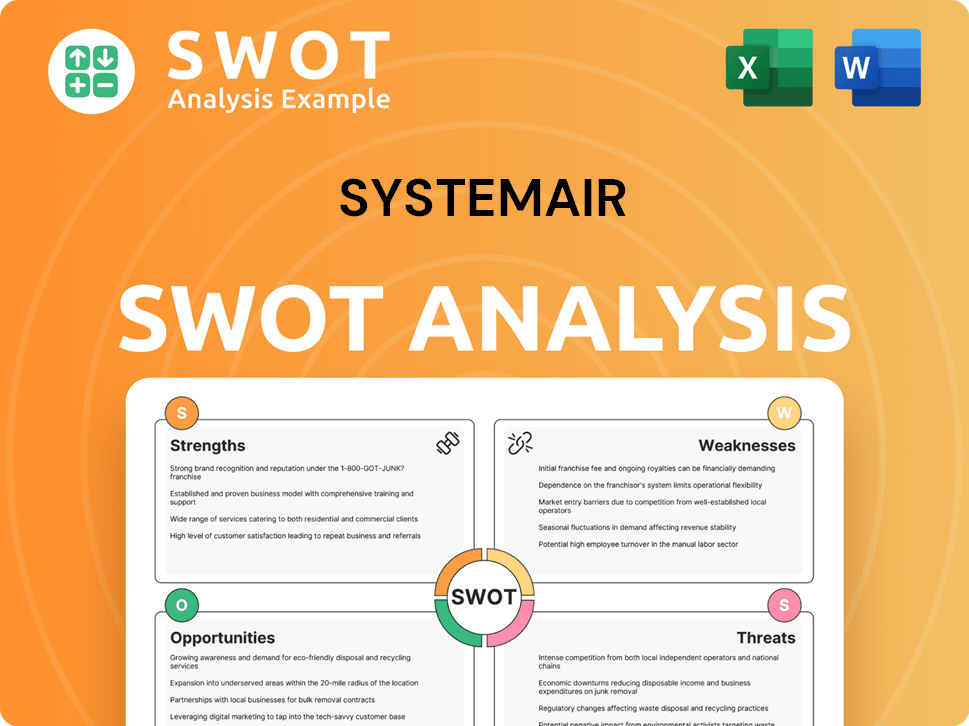
How Does Systemair Invest in Innovation?
The sustained growth of the company is significantly driven by its robust innovation and technology strategy. This strategy emphasizes substantial investments in research and development (R&D), leveraging in-house expertise, and forming strategic collaborations. This approach is key to maintaining a competitive edge in the HVAC market.
A prime example of this commitment is the company's focus on developing cutting-edge heat pump technology. This focus is further propelled by acquisitions like Eneren in 2024. These efforts align with global trends towards decarbonization and green building initiatives, demonstrating the company's dedication to sustainability.
The company is actively pursuing digital transformation across its operations, leveraging automation in manufacturing processes to enhance efficiency and product quality. They are also integrating advanced technologies such as IoT into its ventilation and air conditioning systems, enabling smarter control, predictive maintenance, and improved indoor air quality. This focus on connected solutions aims to provide greater value to customers and differentiate offerings in a competitive market.
The company consistently allocates a significant portion of its resources to R&D. While specific figures for 2024-2025 are not available, the ongoing commitment to innovation suggests a substantial investment, crucial for its long-term growth potential.
Acquisitions like Eneren in 2024 play a vital role in expanding the company's portfolio. These strategic moves enhance the company's capabilities in sustainable climate solutions, supporting its expansion plans in Europe and beyond.
The company is actively embracing digital transformation. This includes automating manufacturing processes and integrating IoT in ventilation systems. These initiatives aim to improve efficiency, product quality, and customer value.
Sustainability is a core focus, with an emphasis on developing energy-efficient products. The company's commitment to reducing energy consumption and minimizing environmental impact drives its product innovation strategy and supports its sustainability initiatives.
Continuous product development, such as high-efficiency fans and air handling units, is a key driver. This innovation meets the increasing demand for sustainable and high-performance building solutions. These new product launches are critical for the company’s growth.
The company's focus on innovation, strategic acquisitions, and sustainability provides a significant competitive advantage. This approach positions the company well in the HVAC market, enhancing its global market presence and long-term growth potential.
The company's innovation and technology strategy is crucial for its future prospects. The ongoing commitment to R&D, strategic acquisitions, and sustainable product development positions the company for continued success in the HVAC market. For more information on the company's origins and early developments, you can read a Brief History of Systemair.
The company's technological advancements are centered around energy efficiency, smart building integration, and sustainable solutions. These advancements are designed to meet evolving customer needs and regulatory requirements.
- Heat Pump Technology: Development and acquisition of advanced heat pump technologies to enhance energy efficiency.
- IoT Integration: Implementation of IoT in ventilation and air conditioning systems for smart control and predictive maintenance.
- Automation in Manufacturing: Use of automation to improve efficiency and product quality in manufacturing processes.
- Sustainable Product Development: Focus on creating products that reduce energy consumption and minimize environmental impact.
Systemair PESTLE Analysis
- Covers All 6 PESTLE Categories
- No Research Needed – Save Hours of Work
- Built by Experts, Trusted by Consultants
- Instant Download, Ready to Use
- 100% Editable, Fully Customizable
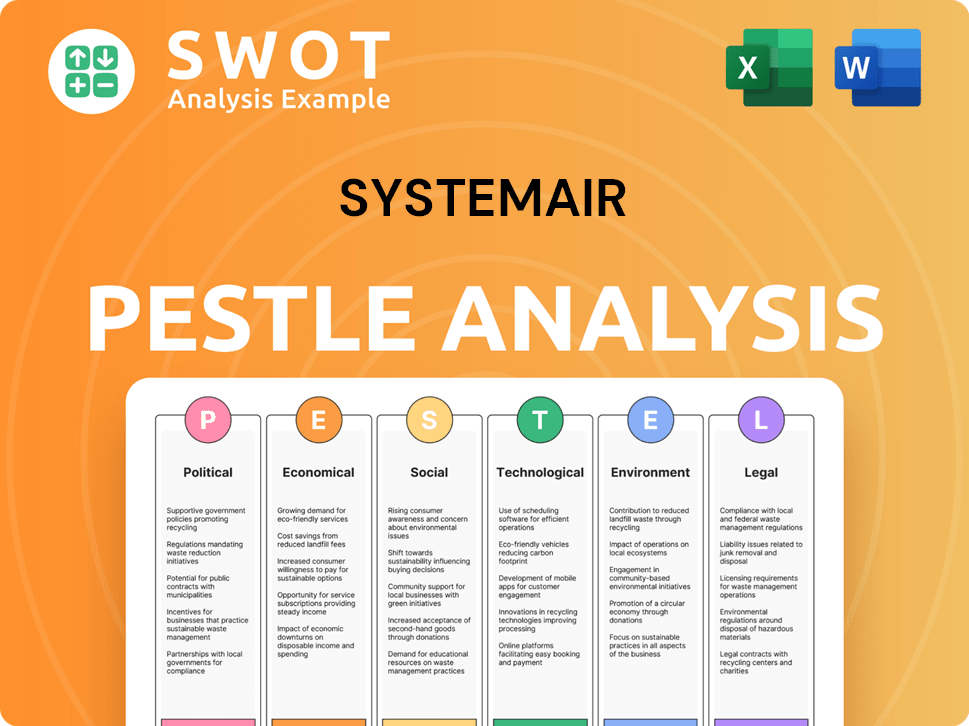
What Is Systemair’s Growth Forecast?
The financial outlook for Systemair indicates a strong commitment to sustained expansion, supported by ambitious revenue targets and a focus on maintaining profitability. The company's recent financial performance showcases its ability to achieve significant sales growth while effectively managing profit margins. This trajectory is further reinforced by a robust order intake, which provides a solid foundation for future revenue streams.
Systemair's financial strategy is geared towards fostering long-term growth and strengthening its global market position. This includes strategic investments in expansion, research and development, and acquisitions. The company's management consistently emphasizes its dedication to achieving profitable growth and enhancing its competitive edge within the HVAC market.
The company's financial ambitions are supported by a strong order intake. For the nine-month period ending January 31, 2024, the order intake was SEK 10,344 million, demonstrating continued demand for its ventilation solutions. This robust order intake supports the company's future revenue growth and market share expansion.
In the third quarter of the 2023/2024 fiscal year, Systemair reported net sales of SEK 3,595 million, a 24.3% increase year-over-year. The operating profit (EBITA) for the same quarter was SEK 411 million, with an EBITA margin of 11.4%. This showcases the company's ability to drive sales growth while maintaining healthy profit margins.
For the first nine months of the 2023/2024 fiscal year, net sales reached SEK 10,796 million, reflecting a 23.4% increase compared to the previous year. The EBITA for the same period amounted to SEK 1,234 million, with an EBITA margin of 11.4%. This demonstrates consistent revenue growth and profitability.
Systemair's investment strategy prioritizes initiatives that support its strategic growth pillars, ensuring that financial resources are effectively deployed to maximize returns. The company's investment levels are expected to remain robust as it continues to fund expansion initiatives, R&D efforts, and strategic acquisitions.
The acquisition of Eneren is a key example of Systemair's strategic approach to expanding its market presence and product offerings. These acquisitions are aimed at enhancing Systemair's competitive position and driving long-term growth within the HVAC market.
Systemair's long-term financial goals focus on achieving profitable growth and strengthening its global market position. These goals are supported by a clear capital allocation strategy that prioritizes investments in areas that drive strategic growth.
- The company's focus on profitable growth is evident in its consistent EBITA margins.
- Strategic acquisitions, such as Eneren, contribute to market expansion and product diversification.
- Investments in R&D and expansion initiatives are crucial for maintaining a competitive edge.
- Systemair's financial performance indicates a resilient and growing enterprise.
For more insights into the company's financial strategy and performance, you can explore the perspectives of Owners & Shareholders of Systemair.
Systemair Business Model Canvas
- Complete 9-Block Business Model Canvas
- Effortlessly Communicate Your Business Strategy
- Investor-Ready BMC Format
- 100% Editable and Customizable
- Clear and Structured Layout
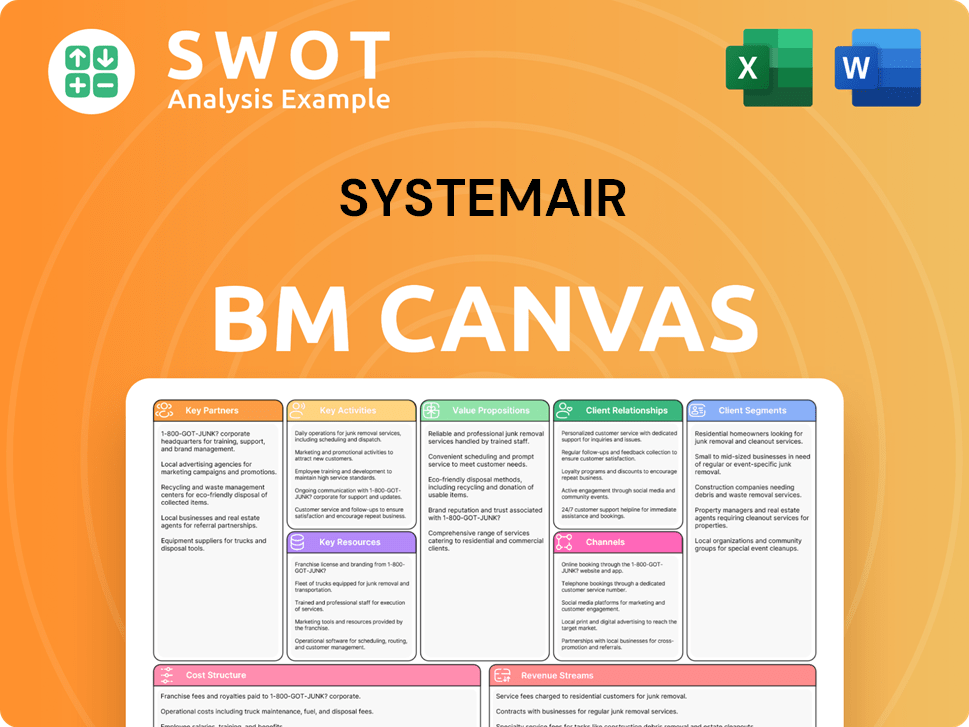
What Risks Could Slow Systemair’s Growth?
The Systemair growth strategy faces several potential risks and obstacles. The company operates in a competitive global market, and must continually innovate and differentiate its products. External factors, such as regulatory changes and supply chain disruptions, can also impact its operations and financial performance.
Systemair's future prospects are influenced by its ability to navigate these challenges. The company needs to manage its costs, adapt to technological advancements, and maintain a strong market position. Its strategic decisions, including acquisitions and investments in localized manufacturing, are crucial for mitigating these risks.
The Systemair company analysis reveals a focus on diversification and risk management. However, the company must remain vigilant and proactive in addressing potential threats. This includes responding to changes in the HVAC market and leveraging opportunities for expansion and innovation.
The ventilation and air conditioning industry is highly competitive, with numerous established and emerging players. Intense price competition and the need for continuous product differentiation are constant challenges for Systemair. Competitors may introduce innovative products, requiring Systemair to adapt quickly to maintain its market share.
Changes in energy efficiency standards and environmental regulations can significantly impact product development costs and market demand. Systemair must continuously adapt its offerings to comply with evolving regulations. Compliance costs and potential market shifts pose risks to profitability and market access.
Global events, such as geopolitical tensions or pandemics, can disrupt manufacturing and delivery timelines. Reliance on specific raw materials and components with fluctuating prices also presents a challenge. Managing supply chain risks is crucial for ensuring consistent production and meeting customer demand.
Rapid advancements in smart building technologies and AI-driven climate control could disrupt the market. If Systemair is slow to adopt or counter groundbreaking innovations introduced by competitors, it could lose market share. Staying ahead of technological trends is critical for long-term success.
The availability of skilled labor and R&D talent can hinder expansion and innovation strategies. Competition for talent and the need for continuous training and development are ongoing challenges. Efficient resource management is essential for executing growth plans.
Economic downturns can reduce demand for HVAC systems, affecting sales and profitability. The construction industry, a key market for Systemair, is particularly sensitive to economic cycles. Diversification across different geographic markets and product lines can help mitigate these risks.
Systemair employs several strategies to mitigate risks. A diversified product portfolio and geographical presence reduce dependence on any single market or product line. Robust risk management frameworks, including scenario planning, help anticipate and prepare for potential disruptions. Strategic acquisitions, like Eneren, expand its technological base. Continued investment in localized manufacturing reduces supply chain vulnerabilities. For additional insights, you can explore the Marketing Strategy of Systemair.
In 2024, the HVAC market is expected to continue growing, driven by increasing demand for energy-efficient solutions and smart building technologies. Systemair's financial performance will depend on its ability to capitalize on these trends. The company's investments in innovation and expansion are crucial for sustaining revenue growth. The company's revenue in the last financial year was approximately SEK 12 billion. The company's stock performance reflects the market's confidence in its strategic direction and risk management capabilities.
Systemair Porter's Five Forces Analysis
- Covers All 5 Competitive Forces in Detail
- Structured for Consultants, Students, and Founders
- 100% Editable in Microsoft Word & Excel
- Instant Digital Download – Use Immediately
- Compatible with Mac & PC – Fully Unlocked
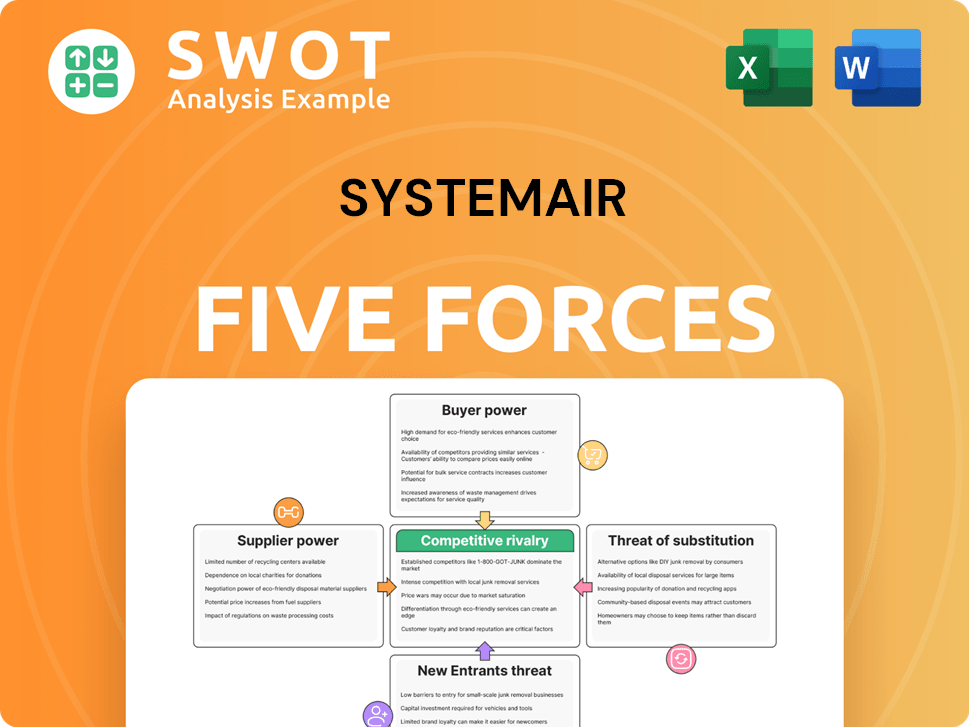
Related Blogs
- What are Mission Vision & Core Values of Systemair Company?
- What is Competitive Landscape of Systemair Company?
- How Does Systemair Company Work?
- What is Sales and Marketing Strategy of Systemair Company?
- What is Brief History of Systemair Company?
- Who Owns Systemair Company?
- What is Customer Demographics and Target Market of Systemair Company?
Disclaimer
All information, articles, and product details provided on this website are for general informational and educational purposes only. We do not claim any ownership over, nor do we intend to infringe upon, any trademarks, copyrights, logos, brand names, or other intellectual property mentioned or depicted on this site. Such intellectual property remains the property of its respective owners, and any references here are made solely for identification or informational purposes, without implying any affiliation, endorsement, or partnership.
We make no representations or warranties, express or implied, regarding the accuracy, completeness, or suitability of any content or products presented. Nothing on this website should be construed as legal, tax, investment, financial, medical, or other professional advice. In addition, no part of this site—including articles or product references—constitutes a solicitation, recommendation, endorsement, advertisement, or offer to buy or sell any securities, franchises, or other financial instruments, particularly in jurisdictions where such activity would be unlawful.
All content is of a general nature and may not address the specific circumstances of any individual or entity. It is not a substitute for professional advice or services. Any actions you take based on the information provided here are strictly at your own risk. You accept full responsibility for any decisions or outcomes arising from your use of this website and agree to release us from any liability in connection with your use of, or reliance upon, the content or products found herein.